Testimonios is a publication by MAA/AMS edited by Pamela E. Harris, Alicia Prieto-Langarica, Vanessa Rivera Quiñones, Luis Sordo Vieira, Rosaura Uscanga, and Andrés R. Vindas Meléndez and illustrated by Ana Valle. It brings together first-person narratives from the vibrant, diverse, and complex Latinx and Hispanic mathematical community. Starting with childhood and family, the authors recount their own particular stories, highlighting their upbringing, education, and career paths. Testimonios seeks to inspire the next generation of Latinx and Hispanic mathematicians by featuring the stories of people like them, holding a mirror up to our own community.
The entire collection of 27 testimonios is available for purchase at the AMS Bookstore. MAA and AMS members can access this e-book for free through their respective member libraries (MAA | AMS). Thanks to the MAA and AMS, we reproduce one chapter per month on inclusion/exclusion to better understand and celebrate the diversity of our mathematical community with folks who are not MAA/AMS members.
De Donde Vengo Yo

Dr. Federico Ardila, Illustration created by Ana Valle.
My elders come from little pueblitos in the mountains of Santander, in northeast Colombia. My dad’s family would be the ones to call if you wanted a serenade for someone in Zapatoca. My great-grandma would host the afterparty and challenge the young ones to trash-talking battles in rhyme. Meanwhile my great-grandpa slept on a hard wooden block, in contrition for his sins. My dad, Jorge, loved math and science as a kid in Bucaramanga and wanted to study engineering. Fortunately, his dad won the Totogol—a sort of lottery where you had to guess the scores of the national fútbol tournament—winning just enough money to open up the corner store that supported the family for the next few years, and send my dad to college in Bogotá. My father began his career engineering sewage systems. With time, he became really interested in designing systems for groups of different people to work together, en armonía. He will tell you that he always prefers to avoid conflict; but if he has to, he’ll always fight for the weaker side.
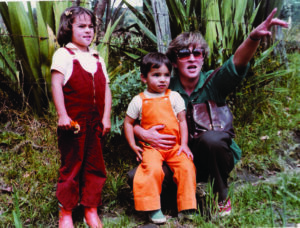
My mom and dad showing us the way.
My mom’s parents migrated to Bogotá escaping from circumstances I will probably never know, and finding common ground in that. My grandma would proudly say she was the first woman to wear pants in her town. She made sure that my mom never learned how to cook so she wouldn’t end up oppressed by some man. My mom, Amparo, was part of the first generation of professional sociologists in Latin America; she managed to graduate before they shut down her department for being too revolutionary. I recently learned she almost called me Fedor, the Russian name for Federico. Amparo devoted much of her life to the NGO [1] she founded and directed her whole life. She helped institute a national sex-education program—this included teaching at my school, and my friends’ schools, and even on TV sometimes; I was not
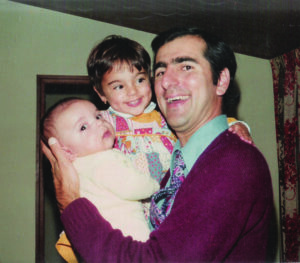
Photos courtesy of Federico Ardila.
amused at the time. She organized women to battle domestic and sexual violence. She helped over-policed neighborhoods develop conflict resolution protocols, away from the police. She fought the National Rifle Association at the United Nations, as she tried to stop the U.S. government from sending weapons to Colombia as part of the “War On Drugs’’. She seemed to think there was no problem too big for her to tackle, no fight that she could not win.
From an early age I was exposed to the beauty of math and science, and I was instilled with a strong sense of social responsibility. One of the big questions of my life is to understand how these two interests and commitments can support each other. I have learned a lot from struggling to find answers to this question.
My Early Years
I grew up in Bogotá, Colombia. I was a really shy and sensitive kid, excited about all sorts of things: fútbol, music, art, typography, reading, writing, math, among many others. My earliest math story, according to my dad, comes from when I was learning how to add. To pass the time while stuck in traffic, he asked me to add the numbers from 1 to 9. I told him “1+9 is 10, 2+8 is 10, 3+7 is 10, 4+6 is 10, and then 5, so the answer is 45.’’ As a math educator, I can see now that my dad had the taste for a good math problem. My mom’s parents challenged me to weekly games of Yahtzee and blackjack, for years. My math development was supported from an early age.
My school, el Colegio San Carlos, was the service project of a North Dakotan abbey. It was highly selective academically, but Father Francis, the school principal, insisted that the school should be affordable. In elementary school we had some awfully conservative North Dakotan teachers, who punished us physically, and implicitly taught us that American whiteness was something we should aspire to. In high school we had some pretty radical teachers, who argued about which guerrilla was most beneficial for the liberation of Colombian people. So that we might fully appreciate Baudelaire’s poetry, our Spanish teacher had us act out a ritual with blindfolds and candles in the school theater, while we read Las Letanías de Satán from Las Flores del Mal. [2] Our teachers were given a lot of freedom, clearly.
My school had a really obnoxious motto: “The best for the best.’’ In English, too! Even more obnoxiously, it seemed to work. Many of my former classmates excel in many fields today: math, biology, music, literature, film, dance, finance, medicine, and others. Surely this is in part due to the quality of the educational experience we were offered. But outside of school, most of us already came from relatively privileged situations. Inside of school, we were raised to think we were the best, and we deserved the best. Privileges, confidence, and entitlement go a long way.
I was raised to not misinterpret all of this as our being exceptional. I remember my mom returning, with a big smile on her face, from a parents meeting where she had a big fight with one of my teachers. She asked the school to stop telling us that we were better than the rest of the country: we were just hard-working kids with resources and opportunities. My teacher told her that I would be ashamed of her if I could hear her. I was really proud of her; I still am.
Olimpiadas
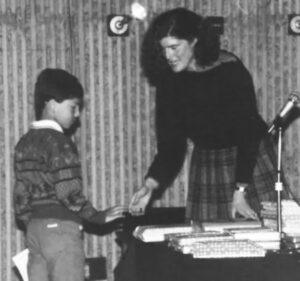
Olimpiadas de Matemáticas with Mary Falk de Losada and my cousin Ana María.
When I was eight or nine, a test of the Olimpiadas Colombianas de Matemáticas arrived at my school. I still remember one early question: A snail climbs up a ten-meter pole. Each day it climbs up three meters, gets tired, falls asleep, and slides down one meter overnight. How many days does it take for the snail to reach the top? I was really excited and amused when I solved this problem. I had no idea that math could be this creative, even funny!
I fell in love with math through the Olympiads. They also opened up the world for me: I qualified for the Colombian national team, and got to travel to Sweden, Russia, Turkey, Hong Kong, Argentina, and Mexico as a teenager. These were amazing experiences mathematically and personally, and they showed me that this path could open doors for me that I had not imagined. It took me very long to understand and accept that I wanted to be a mathematician, but the seeds were planted early on. I have to thank the director, Mary Falk de Losada, who had a huge impact on my generation of mathematicians in Colombia. To tell the complete story, though, my older sister Natalia and cousin
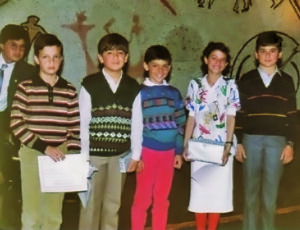
Photos courtesy of Federico Ardila.
Ana María had done really well in the Math Olympiads before me. My sister tells me that the (very male-dominated) summer camps—the same ones that were so encouraging and nurturing to me—were really uncomfortable for her, so she left. It is much easier to be in the majority.
Access
The Colombian market was closed to foreign products in the late 1980s and early 1990s. To keep up with my obsessions I had to be resourceful. Fútbol was not shown on TV; the closest I could find was an instructional booklet featuring Pelé. Each page had a photo of him doing a different move: “remate con el borde externo,’’ “cabezazo lateral,’’ “parada de pecho.’’ I lined up all the neighborhood kids and made everyone do daily drills, one move per day, until we finished the book. We all have solid technique today. Apparently I’ve had a teacherly instinct from a young age.
My quiet rebelliousness drew me to the loudest music I could find. A proud teenage memory was getting El Tiempo, the largest newspaper in Colombia, to talk about Suicidal Tendencies, a largely Chicano hardcore punk band from L.A. that I loved. All of this music was completely unavailable in the Colombian market, so I plugged into an intricate system of trading tapes with kids I never met. The arrival of a mystery music tape—complete with our best rendering of the band’s logo, which we had never seen, and our best understanding of the lyrics—gave me a thrill for days! I am still really thankful to “M.’’, a frequent correspondent whom I never met, for shaping my musical taste.
Good math books? I had no idea where to find them. Our teachers withheld their books from us, since that is where our exams came from. I heard someone had sneaked in some great little math pamphlets from Cuba and was selling them in the black market neighborhood where I bought pirate music tapes. They only had a few books but they were written by top Soviet mathematicians, and funded by the USSR, so they were excellent and very affordable. I first heard about the 4-dimensional cube from El método de coordenadas by Gelfand, Glagolieva, and Kirillov. It is still one of my favorite mathematical objects, and Gelfand’s work has been hugely influential in my career.
At the International Mathematical Olympiads, I met young mathematicians all over the world and we agreed to send each other math problems that we liked. I loved receiving their letters and I spent many, many hours at home, trying to solve problems from my pen-pals, and from journals like Crux Mathematicorum that they sent to me. Meanwhile, I was one of those annoying kids who pretended that I wasn’t even making an effort, that things just came naturally to me. I guess that growing up around lots of toxic masculinity, like I did in my school, I learned to do anything to avoid getting bullied. Being a “genius’’ was socially acceptable, but not being a hard worker! I still don’t find it easy to struggle in front of other people, and that gets in my way as a mathematician.
Psychology
The International Mathematics Olympiads made me confront the human, emotional side of doing mathematics very early on, a las malas. It was made clear to me that I was expected to win Colombia’s first gold medal at the IMO, and I worked super hard to fulfill that promise. I reached the point where I felt like I could solve any math problem you would give me.
I went from overconfident to terrified during the course of one long plane ride. I knew I was a strong mathematician for a Colombian, but as soon as I saw the Russians, Americans, Chinese, Romanians, and Iranians (Maryam Mirzakhani being one of them) I was convinced, inside my body, that I couldn’t possibly do as well as them. I did not sleep the night before the exam, and I froze when I received it; I simply could not think. I watched the Chinese student sitting next to me hard at work, and despaired. I put in one of the historically poorest performances by a Colombian in the IMO. So did most of my teammates. Today, I have no trouble understanding students who tell me they freeze in front of an exam.
During my last year in the Olympiads, it was decided that we would address these emotional, psychological barriers as a team. As part of our training for the IMO, we enrolled in a group meditation program. (I recently learned that the founder was José Silva, a Chicano self-taught parapsychologist from Laredo, TX—a controversial and fascinating figure.) We were skeptical; I must say it felt a bit like a cult to me. But we meditated daily and even did a team meditation right before walking into the IMO exam. We already had a reputation for being the weird team that was always singing loudly wherever we went, and now people thought we were even stranger. That was the only Olympiad exam where I felt that I showed what I was capable of.
I did not win that gold medal because I could not solve the combinatorics problem. I felt OK with that. I did learn that, to be the mathematician that I wanted to be, I needed to be mindful of the human side of doing mathematics. Now I’m convinced that the time and energy that I spend growing as a human being—feeding my spirit, confronting my flaws and my insecurities—also makes me a stronger mathematician.
Applying to College
As much as I loved to learn, I had a problem with authority, like many high schoolers. I would solve math problems, but not the ones given for homework. I would read literature and talk philosophy in my spare time, but not the books I was assigned. My friend Juan Carlos and I had a deal with the school guard: we gave him a sandwich or a beer and he let us sneak out of school. We spent countless afternoons in seedy billares, with a bunch of men from all walks of life, together in solitude; billiards cue in one hand, beer in the other, words rarely spoken. I barely graduated from high school. I failed physics, and to be allowed to pass, I had to come up with a recuperación. I made a video showing off the most physics-defying carambolas that I knew how to do. The video did not showcase much of an understanding of physics, but the teacher was impressed. The hours and hours I spent playing billiards paid off.
When it came time to apply to college, one of my friends told me he wanted to go to this U.S. school that had strong science and a great financial aid policy: if you got in, they’d make it possible for you to attend. I had never even heard of this school, and my family certainly could not afford it. But this financial aid deal sounded good, and the application materials had an intriguing punk-rock aesthetic that spoke to me, so I applied. I was admitted and went to MIT.
Had I known how selective MIT was, I would have known that I wasn’t going to get in: I was failing half of the subjects in school at the time! I probably wouldn’t have bothered to apply. My ignorance helped me.
The accidental lesson I learned is that I think one should overreach for opportunities in life. There are many people, institutions, structures, who will close doors on us. Our job is to never close doors on ourselves, but to try to open them, push hard to try to get in, and if we do, make sure to keep those doors open for others to come in.
Undergraduate Years
At 17, migrating to a new country and gaining access to an MIT education was tremendously exciting, if a bit scary. It was also a big culture shock. The undergraduate experience there was brutal. When I saw the amount of work that was assigned, I honestly thought professors were not being serious. I also played soccer for MIT, so the daily practices and games made it impossible to complete the work. That was fine by me, I was (maybe too) used to not completing work. But almost all my classmates had always been at the top of their class, had never failed an exam in their lives, and at MIT, many of them failed. This made for a horribly unhealthy environment: people worked way too hard, drank way too much coffee, and pulled all-nighters every other night. This didn’t work for me; if I was going to succeed here, I would have to do it my way. Of course, I did study harder than I ever had. But I moved off campus and tried to have a balanced life outside of school.
The flip side, which I only realized many years later, is that I was extremely isolated as a mathematician. I felt so different from my classmates, and found the social atmosphere so uncomfortable that I avoided the department altogether. During my whole undergraduate career, I never collaborated with anyone on homework or went to a single office hour. I am not proud of this and certainly don’t recommend it. I just thought that’s how it was. But now I know that many students from underrepresented groups experience a similar isolation. I often find myself advising students not to let this happen: find people you trust and talk math with them; get used to the discomfort of discussing things you don’t quite understand yet and grow from that discussion. Don’t let your lack of confidence or your pride, two sides of the same coin, get in the way of your learning. But that’s easier said than done, and really, this isolation is a big systemic problem that our math departments and programs need to face.
Aside from my classes, I was still obsessed with problem solving and spent probably too many hours preparing for the Putnam competition. I barely missed being a Putnam Fellow because I could not solve the combinatorics problem, once again. The mistake I made there, and I had also made in my last IMO, gave me a very helpful lesson in my research: you should not spend all your time trying to prove something that is not true.
I still didn’t know what I wanted to do with my life until my senior year, when I took Algebraic Combinatorics with Sergey Fomin and Enumerative Combinatorics with Richard Stanley; I just loved them! Although combinatorics was always the hardest field of mathematics for me, these classes convinced me that I wanted to go to graduate school in combinatorics.
Graduate Years
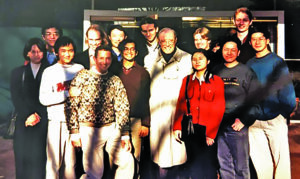
With Prof. Gian-Carlo Rota and his students at MIT. Photo courtesy of Mark Skandera.
When it came time to apply for graduate school, I casually asked Richard Stanley for some good places to study combinatorics. He told me the names of four researchers, so I applied to those four schools, and to MIT. When it came time to choose schools, people asked me: “Wait, why didn’t you apply to the top schools?’’ The thought did not even occur to me. I still didn’t know what the “top schools’’ were, or why it was so important to go to them. (I still don’t think the “top schools’’ necessarily offer the best education, but I can’t deny that most math departments only seem to want to hire graduates of the same few schools.) So people advised me, “Well, given your options, you should stay at MIT.’’ I did.
I took some great classes that shaped my mathematical interests: matroids with Gian-Carlo Rota, hyperplane arrangements with Richard Stanley, Coxeter groups with Sara Billey and Anne Schilling, algebraic geometry from Ravi Vakil, and Lie algebras from David Vogan. I took some awful classes too.
My PhD advisor, Richard Stanley, was and continues to be a huge mathematical influence to me. He is one of the founders of my field of research; he was able to draw deep connections between combinatorics and other fields that no one had foreseen before. More plainly, I really enjoy his taste in mathematics. At the time, Richard had 11 PhD students, and I only talked to him once or twice a semester. I didn’t know this was unusual. He suggested some interesting problems, but I struggled to make progress.
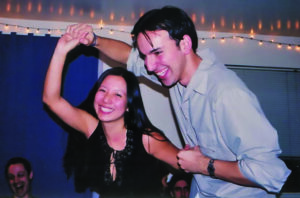
Salsa with May-Li. Photos courtesy of Federico Ardila.
I sometimes joke that I did my PhD in fútbol and salsa. I was on the MIT graduate soccer team, and at one point I was in eight other teams; so I played almost every night. I would also go dancing three or four nights a week with a crew of Colombians and my best friend May-Li, who became my life partner. Those were really fun and happy years.
And yes, it was fun, but years later I realized it was also escapism. Sometimes I just lost motivation and interest in my research; at an especially bad time, I hid from the math department for a whole semester and did construction work instead. I don’t think anyone in the department noticed. I moved into a depressing little basement space, more boiler room than bedroom, where someone had recently died from alcohol poisoning. I was offered free rent in exchange for converting it into a livable space: I took out the flooring, put in a new floor and carpet, installed plaster walls and electricity jacks, hung a drop ceiling, the whole thing. I am not a very
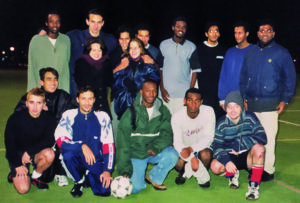
Fútbol with the International Students Association.
handy person; this was a real challenge. But I could see the progress! I would put in the hours and have something tangible to show for it at the end of the day, not like math.
Eventually I got back on track. I ended up finding my own research directions that I got very excited about. At each meeting I would give Richard a short update, and he would quietly walk to his massive book shelf, grab what seemed like a randomly chosen paper to me, and tell me to read it. It would take me some time to understand why this paper was just what I needed to read. I proved some theorems that I was proud of and people in my field found interesting, and I graduated.
Postdoc Years
I turned in my thesis in December, applied for jobs in the U.S., and moved to Colombia for the spring semester, while job offers hopefully arrived. I soon learned that, upon leaving the U.S., my student visa was revoked and I was not allowed to apply for another visa for another 1–2 years. I had to cancel seminar talks, an invitation to the Clay Math Institute, and my plans to go to my own graduation. A few weeks later, I got a phone call inviting me to interview for a position at Microsoft. Now, maybe I shouldn’t confess this, but I will: I knew nothing about this position, and I really had no interest in working at Microsoft, but I thought “Hmm… maybe Microsoft can get me a visa!’’ So I told them I would love to come for an interview. Two days later I had my visa. I could go to my graduation!
Of course, I went to the interview, and I was pleasantly surprised: I would spend one year at MSRI in Berkeley and one year at the Microsoft Theory Group—an academic research job with a really stellar group of mathematicians. Also importantly for me, one year of a corporate salary would allow me to pay all my loans within a year and move back to Colombia right afterwards. I took the job.
On a personal level, moving to the Bay Area was life changing for May-Li and me. It was the first time we felt at home in the U.S.: For a young Asian-Latinx couple fascinated with the countercultures of the world, tired of the Boston weather, excited to be reminded what fruit is supposed to taste like, the East Bay felt like an immediate fit.
I spent most of my postdoctoral years working at the intersection of combinatorics and algebraic geometry, with the guidance of Bernd Sturmfels and Sara Billey. I wrote my first joint papers with Carly Klivans and Lauren Williams, on the combinatorial foundations of tropical geometry; this turned out to be influential work. More importantly for me, I really enjoyed working on this topic and working with Carly and Lauren: they completely changed my understanding of how I like to do math research. I’ve only written a handful of solo papers since then.
SFSU
At the end of my postdoc, May-Li and I were ready to move to Colombia—where, newly married, we were excited to build a life together—so we decided to only apply to a handful of dream jobs in the Bay Area, New York, and Vancouver. I was told that I was doing it all wrong and damaging my career. But we wanted a good life in a big, diverse city, with abundant opportunities for May-Li. I didn’t want to pretend otherwise or play academic strategy games to try to get there. I got an offer at San Francisco State University, where I have been since then. Moving away from the Research 1 universities, I felt an unexpected, immediate sense of relief: I could leave the research rat race and do the work that I wanted to do, without pressure. Under these conditions, I feel I have done much better work.
SFSU has been a wonderful mathematical home for me. I feel lucky to be in a department with a strong combinatorics research group and amazing teachers and math education scholars to learn from, where service outside of mathematics is valued. The university has the attitude that our job is not to select and support only the top students, but to serve the students that come to us. I had never experienced this approach before in my schooling.
The first Ethnic Studies departments in the U.S. were established at SFSU in 1968, thanks to student activism, and that commitment to racial and social justice is still very much present on some parts of our campus. This has led to a wonderfully diverse community of students, whom I learn constantly from. I don’t think I understood how much this would mean to me until I arrived to those classrooms; I felt so much more at home!
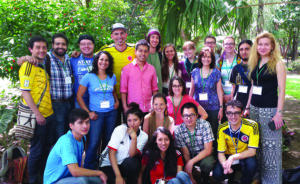
The Encuentro Colombiano de Combinatoria in Medellín, 2016.
As soon as I realized that I wasn’t returning to Colombia in the near future, I looked for ways to remain involved there. I started the SFSU-Colombia Combinatorics Initiative [3] and the Encuentro Colombiano de Combinatoria. [4] I am really proud of what we are building over the years. With the help of a strong international community, these have become really empowering mathematical spaces to many people, and led to fertile mathematical collaborations between Colombia, California, and many other locations. Within its means, SFSU has been tremendously supportive of this work.
There is a very skewed point of view in many math PhD programs, where people think the only successful route for a mathematician is to get a tenure-track job in a research school. If you can’t do that, then you go make a lot of money in industry. Or if you’re one of these unusual humanist types, you try to go to a fancy liberal arts school in a perfectly manicured little town. It felt to me—sometimes it still feels to me—that my research peers could not understand why I chose to go to a big urban public school with no PhD program, what strange value system led to this. What can I say? I really enjoy working here, and I really like the way that it has shaped me as a scholar.
Balancing with Personal Life
Soon after moving to the Bay Area, I joined Left Wing Fútbol Club, an organization conceived as an alternative to the largely cis male, straight, white, affluent, win-at-any-cost, dominant culture of U.S. soccer. The team was made up of community organizers, educators, artists, rappers, and others trying to create political change through our professions. We had complete newcomers to fútbol and former professional futbolistas. With a good dose of Bay Area idealism, fútbol was seen as a metaphor for the kind of world we’d like to live in. Less experienced players would receive the ball most often, to have the opportunity to improve. In tournament games, everyone got equal playing time. The score was always 2-2. This will all sound very strange to anyone who played competitively before (like me!); it certainly wasn’t a recipe for winning competitions. But on a good Sunday, it was the most liberating fútbol space I participated in in my adult life. I don’t play actively with them these days, but LWFC showed me how to radically reimagine a space that I thought I understood very well.
My partner May-Li and I also started the DJ collective La Pelanga with some dear friends. We wanted a positive dance floor focused on the music and dancing, free of the sleaziness.We are obsessed with how music constantly migrates back and forth between Africa, the Caribbean, and the Americas, with no regard for borders. Recently we have started doing more cultural and political work. We DJed Radio Ambulante’s [5] first live show and the Oakland Museum’s exhibit on migration. We set the musical stage for a collective smashing of a piñata rendering of the border wall, led by artist Sita Kuratomi Bhaumik. We provided the soundtrack for the People’s Kitchen Collective series of meals from the Farm to the Kitchen to the Table to the Streets, and for their annual celebration of the Black Panthers’ Free Breakfast Program.
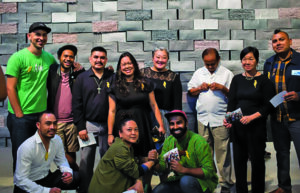
amos Contra el Muro, led by Sita Kuratomi Bhaumik, 2016.
With time, DJing has become a second career for me. For many years I thought I should hide this from my colleagues and students. I couldn’t really tell my department why I would rather not teach morning classes. I would arrive to class, still star-struck, wishing I could tell my students “You’re not gonna believe it, I got to DJ for Celso Piña last night!!!’’ But one time a young woman danced over to the DJ booth to tell me that she loved the music; then I saw she was my student and she saw I was her professor; I don’t know who was more in shock. Eventually the word got out, and I cannot tell you how many young mathematicians I have met who are also DJs, or bassists, or community organizers, or dancers, or athletes; they are usually worried that they will have to drop that to stay in math.
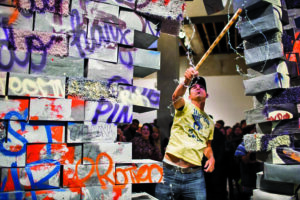
Photos courtesy of Sana Javeri Kadri.
So I’ve come to realize that it’s important to share these parts of my life as well: for myself and for so many others who have felt that they need to hide the things we love to be accepted as “legitimate” mathematicians. Perhaps unsurprisingly, when I look at the way that I do my work as a mathematician in my research, my teaching, and my organizing activities, I find a very clear influence of the lessons I have learned from these spaces and these wonderful collaborators and friends.
Balancing Act: Research/Teaching/Service
A constant source of joy and anxiety throughout my career has been to find the balance in my growth as a researcher, as a teacher, and as an organizer. I have never wanted to do one without the others. I am reminded of the end of my sabbatical year in 2013, when I had my head buried deep into lots of exciting research projects.
I was trying to figure out how I would balance them with my recently increased 3-3 teaching load—a strange perk of earning tenure in my department. Then, during the same week, I received invitations to become editor-in-chief of my favorite combinatorics journal (JCTA) and to co-direct my favorite program for young mathematicians of color (MSRI-UP). Each was a really exciting opportunity and a really overwhelming commitment. It was immediately clear that if I was going to accept one, I was going to accept the other also. I did.
My mathematical work is what gives depth and excitement to my teaching and community work. Ironically, my research is also what has given me the access to do the more human side of my work: whether I like it or not, in mathematics we are measured by our theorems, first and foremost. My teaching and community work are what give humanity and meaning to my mathematical work.
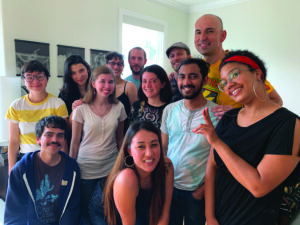
Annual Federico-cooks-for-his-thesis-students lunch. Photo courtesy of Federico Ardila
The classroom and mentoring my 50 thesis students has been an immense joy. [6] My so called “service work’’ cannot be seen as service work: I have grown and learned immensely from those whom I have supposedly “served’’.
Finding the time and energy to do all of these things is a different, challenging question. It certainly helps to be in a balanced relationship with my partner May-Li, who is tremendously passionate about her own career, who supports mine, and who constantly inspires me and teaches me. It certainly helps that we decided not to have children. It certainly helps that we don’t have a TV. But I do know that I have had many times in my life when I am putting too much time and energy into my work. I have struggled with my health more than once because of it.
I will never forget the elder whom I met at a party a few years ago, who told me about her experience doing organizing work in Oakland and at SFSU in the 1960s and 1970s as a Black Panther. She asked me what I do and patiently listened to me go on for a bit too long about the many projects I was excitedly involved in. She lovingly put her hand on my shoulder, looked me in the eye, and said “Honey, it’s wonderful that you are doing meaningful work; I can see that your students are lucky to have you. But you gotta take care of yourself. This work is a marathon, not a sprint. Can’t forget to have fun while you’re doing it, too.” I’m working on that.
The Difficulties
Still today, 25 years into my career, I sense in myself a tendency to make it seem like my path has been effortless, like I have it all figured out. I already said that the path that I walked on was paved by others, and it was already relatively smooth by the time I walked it. But Colombians frequently rank as one of the happiest peoples in the world, despite living through a civil war that has lasted my whole lifetime. We have an astounding capacity to rewrite our stories to make them a bit easier to swallow. And within mathematics, I’ve been hesitant to talk about things that have brought me a lot of anger and pain.
The numerous times my students and I carried 200 large bags of Colombian coffee to gift to professors at the International Math Olympiads, only to have some of them joke that we forgot to bring them the cocaine too. The time as a student when I proudly discovered a new mathematical object, simultaneously to some experts in the field, and one of them tried to get me to confess that I had stolen their work. The first time I was invited to give a talk in an algebraic geometry conference, and the experts spent 3/4 of my allotted time arguing about whether the question was even worth asking, and did not let me give my talk. The time that staff turned me away from the graduation ceremony of my Berkeley PhD student because they wouldn’t believe me that I was his advisor. The time when an officer at the Spanish consulate refused to read my invitation and visa application to attend the International Congress of Mathematicians 2006 because she had too much work already, so I politely asked to speak to her manager, and she called the police on me, so I had to leave and miss the ICM. That Sunday when I forgot the keycard to enter my office building, and the SFSU police spent an hour confirming that my school ID and the departmental website were not lying, that I am indeed a math professor. The time I wrote a paper [7] on geometry, robots, and their use in society, and a referee wrote: “The math is very interesting; I don’t know about these ethical ruminations. And is the author uncomfortable because a police robot killed a black person, or because they killed a person? What does ‘Black Lives Matter’ have to do with this?’’ The math conference where two of my students and I were kicked out of a bar, for no reason other than being the only non-white people there, cutting short our celebration of their recent accomplishments. The time when a book publisher read my book proposal and told me “Oh, I thought Colombians were good at drugs, not at mathematics.’’ The time that a very prominent mathematician copied a large part of a grant proposal that I had shared with them, submitted it as their own, and won a large NSF grant with it. The time I received e-mail threats for talking about the role of mathematics in policing. Each time I did not make a big deal of it, as I had less power than them, or I felt this could hurt my career or get me in trouble, or I simply did not have the energy. Each time I told myself my work is not my life; this does not matter that much to me. But I still think about these episodes; they do matter.
I’ll also state the obvious. Although I have received awards that celebrate my research, my teaching, and my mentorship, there are numerous times when I did not know how to support my students, mentees, and collaborators, and inadvertently caused a lot of pain. It often had to do with my inability to notice hidden power structures playing out in mathematical spaces that I was responsible for. I am extremely grateful to my students, my friends, my partner May-Li—mostly women of color—who have bravely and generously shown me what I could not see, and taught me to do a bit better every time. If there is something that I think I have done right in my career as an educator, it has been to listen to and learn from them.
Our Worth
There are times when life simply will not allow you to function at work. If you look through my CV, you will find gaps in my “productivity” that have raised questions, that have closed some professional doors for me. Difficult times are hiding behind those gaps, but I am proud of them; there is a lot of growth there.
Several years ago, my mother suddenly suffered brain damage and went into a coma for the last nine months of her life. I spent a lot of that time with her, from near and from far; more than I had in 15 years. I learned to quiet down enough to accompany her very slow pace; to perceive her deep but very subtle communication. My mother had always been a proud and fiercely independent woman, constantly working at the service of others; depending this much on others was most certainly her worst nightmare. But these horribly difficult times also brought her moments of absolute bliss. Regardless of what she could or could not do at that point, Amparo was an immensely valuable human being, capable of giving and receiving love. This was a very hard lesson for me to learn, but it has been immensely valuable.
Soon after I learned that I had won the 2019 national teaching award of the Mathematical Association of America, I suffered a concussion on the fútbol field. I could not exercise, or read, or look at a screen, or listen to music, or talk to anyone for more than a few minutes. I do not mean to overdramatize the situation; but after several weeks of this, in a very real way, I was not sure whether I would still be a teacher, or a mathematician. I spent days and days and days in the woods and the ocean. This city kid, lucky to be living in the beautiful Bay Area, drew a lot of strength from the trees for the first time in his life. I learned how to meditate again and spent a lot of time doing it—there was little else I could do! This was a time of huge personal growth. So what if I was not a mathematician? Surely I was much more than a mathematician, right? (Right?)
I have always known that our profession (and our capitalist society, more widely) has the uncanny ability of making us feel that our worth is intimately tied to what we produce: the theorems we discover, the papers we write, the grants we receive, the awards we win, the classes we teach, the students we mentor, all of that. When we are not able to or do not wish to do any of these things, what is our inner worth? It can be a heavy question, but I think it is one worth considering.
Embracing Nepantla
When straddling different worlds is a part of your identity, there is a lot of discomfort there, but there are also unique insights that you have to offer. I have been really inspired for years by the concept of nepantla, which I learned about from my friend Rochelle Gutiérrez. [8] As I understand it, nepantla is a Nahuatl word which roughly means the space in between. Chicana scholar and poet Gloria Anzaldúa used it to describe the point of view of living in the borderlands between different cultures; of not being in one place or the other; of seeing the world from different, sometimes contradictory lenses. It is a place of tension and discomfort, but it is also the place where transformation takes place. The discomfort is necessary and even desirable, as it signals the growth that is taking place inside you.
I find myself in this place very often: in my personal life, as a Colombian-American, as a Latinx-latinoamericano, as a member of a Chinese-Indonesian-Dutch-Canadian-Colombian-American household; in my research life, as an algebraic geometric topological combinatorialist; in my larger professional life, as a researcher-educator-organizer, as a somewhat public figure who often needs to hide from people, as a mathematician-DJ, as an insider-outsider who benefits from academic structures that he dislikes and is working to transform.
I imagine that many readers of this testimonio are very familiar with these in-between spaces. On either side of these visible or invisible borders, there are people and structures that do not understand where we are coming from, and may try to invalidate our point of view. But more interestingly and more importantly, there are bridges to be built. I think this is where we can best contribute. Building these bridges has been the most challenging and rewarding part of my personal and professional lives.
[1] NGO stands for Non-Governmental Organization, which is a nonprofit organization that operates independently of any government, typically one whose purpose is to address a social or political issue.
[2] English: The Flowers of Evil is a volume of French poetry by Charles Baudelaire. First published in 1857, it was important in the symbolist and modernist movements. The poems deal with themes relating to decadence and eroticism.
[3] Ardila-Mantilla, Federico. “Todos cuentan: Cultivating diversity in combinatorics.’’ Notices of the AMS 63, no. 10 (2016).
[4] Ardila-Mantilla, Federico, and Carolina Benedetti. “Todxs cuentan in ECCO: community and belonging in mathematics.’’ arXiv preprint arXiv:2008.02877 (2020).
[5] Radio Ambulante is a narrative podcast that tells uniquely Latin American stories in Spanish.
[6] Ardila-Mantilla, Federico. “Todxs cuentan: building community and welcoming humanity from the first day of class.’’ arXiv preprint arXiv:2008.02835 (2020).
[7] Ardila-Mantilla, Federico. “CAT(0) geometry, robots, and society.’’ Notices of the AMS 67: 977–987.
[8] Gutiérrez, Rochelle. “Embracing Nepantla: Rethinking ‘knowledge’ and its use in mathematics teaching.’’ REDIMAT 1.1 (2012): 29–56.
Previous Testimonios:

This is a wonderful publication! Thank you so much for taking the time to highlight our Latinx and Hispanic mathematicians!
I am a Math ESOL teacher for our district, and was wondering if these testimonials could also be found in Spanish? This particular narrative spoke to me since I currently have a student from Colombia who is seeking to pursue a career in the medical field. I think being able to read about Dr. Federico Ardila Mantilla in her native language would be powerful and inspirational for her.
Thank you again and I look forward to purchasing the book!
I just checked with one of the editors, who said that there are not currently Spanish versions, but she expects that there will eventually be Spanish versions.